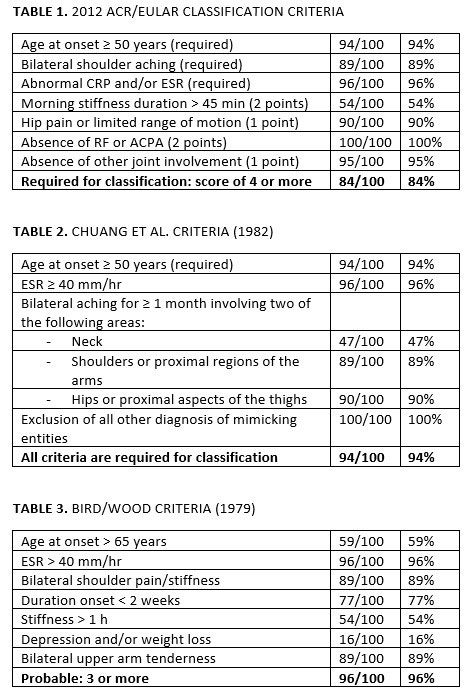Session Information
Session Type: Poster Session (Sunday)
Session Time: 9:00AM-11:00AM
Background/Purpose: Polymyalgia rheumatica (PMR) diagnosis is based on clinical and analytical features characterized by shoulder and pelvic girdle pain associated with elevated acute phase reactants. Traditionally, Bird et al. and Chuang et al. criteria have been used for establishing PMR diagnosis. In 2012 an international working group developed new European League Against Rheumatism (EULAR)/American Collegue of Rheumatology (ACR) classification criteria for PMR.
Purpose: a) To compare the performance of Bird et al., Chuang et al. and 2012 EULAR/ACR classification criteria for PMR in a single-center study. b) To describe the characteristics of the patients excluded by these criteria.
Methods: We included 100 patients with new-onset PMR who were consecutively diagnosed over a 7-year period in a referral center by experienced rheumatologists. PMR diagnosis was confirmed during a prospective 24-month follow-up after excluding other mimicking conditions. Rheumatoid factor (RF) and anticitrullinated protein antibodies (ACPA) were determined in all patients. Subjects were classified by each of the three different criteria.
Results: We studied 100 patients (61 women/39 men); mean age 67.1 ± 10.2 years. 96% of the patients fulfilled Bird et. al criteria, 94% fulfilled Chuang et al. criteria and 84% of the patients fulfilled 2012 EULAR/ACR criteria (TABLE 1, 2 and 3). We assessed the characteristics of the 16 patients who did not fulfilled 2012 EULAR/ACR criteria: 6 of them were under 50 years of age (range age 43-48 years). Another 10 patients did not complain of pain/stiffness in the shoulder girdle at any time. However, they presented a predominance of inflammatory pelvic girdle pain and elevated acute phase reactants.
Conclusion: In our single-center experience we found that 2012 EULAR/ACR criteria classified most of our patients. However, patients who presented predominant pelvic girdle affection and those who were under 50 years old despite showing all the rest of clinical and analytical required items were excluded. Some of these patients fulfilled Bird and/or Chuang criteria.
To cite this abstract in AMA style:
PRIETO- PENA D, Calderón-Goercke M, Gonzalez-Mazon I, Martín-Varillas J, Sanchez-Bilbao L, Atienza-Mateo B, González-Gay M, Blanco R. Application of Different Sets of Classification/diagnostic Criteria for Polymyalgia Rheumatica: Single Center Study of 100 Patients [abstract]. Arthritis Rheumatol. 2019; 71 (suppl 10). https://acrabstracts.org/abstract/application-of-different-sets-of-classification-diagnostic-criteria-for-polymyalgia-rheumatica-single-center-study-of-100-patients/. Accessed .« Back to 2019 ACR/ARP Annual Meeting
ACR Meeting Abstracts - https://acrabstracts.org/abstract/application-of-different-sets-of-classification-diagnostic-criteria-for-polymyalgia-rheumatica-single-center-study-of-100-patients/

